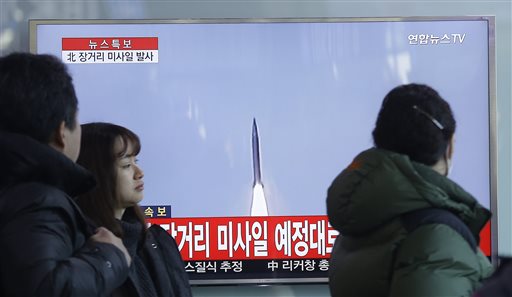
South Koreans watch a TV news program with a file footage about North Korea’s rocket launch at Seoul Railway Station in Seoul, South Korea, Sunday, Feb. 7, 2016. North Korea defied international warnings and launched a long-range rocket that the United Nations and others call a cover for a banned test of technology for a missile that could strike the U.S. mainland. The letters on the screen read: ‘North Korea launched a long-range missile.’ AP
SEOUL, South Korea — The rocket North Korea launched this week appeared to be more powerful than one fired in 2012, with an increased range of 12,000 kilometers (7,500 miles) which puts most of the US within reach, a South Korean defense ministry official said Tuesday.
The three-stage rocket was confirmed to have put an object into orbit but it has not yet been verified whether the alleged satellite is functioning, he told journalists, speaking on condition of anonymity.
READ: US hopes to send anti-missile system to S. Korea ‘as quickly as possible’ | China voices ‘deep concern’ about possible deployment of US missile system
The rocket was similar to the Unha-3 launched in December 2012 but is believed to have a range of 12,000 kilometers (7,500 miles).
The old model was estimated to have a range of some 10,000 kilometers.
“However, we need more analysis to determine the capacity, including its exact range,” a defense ministry spokesman told AFP.
There had been speculation the North might use a much larger rocket this time after having completed work on an extended 67-metre (220-foot) gantry tower capable of handling a launch vehicle twice the size of the 30-metre Unha-3.
North Korea, however, has not yet mastered key technology needed to turn the rocket into an inter-continental ballistic missile — a re-entry vehicle to protect the warhead from heat, the official said.
The rocket, carrying an Earth observation satellite, blasted off Sunday at around 9:00 am Pyongyang time (0030 GMT) and, according to North Korean state TV, achieved orbit 10 minutes later.
The launch, widely seen as a disguised long-range missile test, sparked international condemnations and resulted in an agreement at the UN Security Council to impose new sanctions against the increasingly defiant state.
The flight path of the latest rocket was also similar to the 2012 launch vehicle, whose first stage debris was recovered by South Korea off its western coast.
North Korea this time is believed to have had the first stage of Sunday’s rocket blow up into 270-odd pieces to cover up its technical footprint, the official said.
The North is already subject to numerous UN sanctions over previous rocket launches and three nuclear tests in 2006, 2009 and 2013.
RELATED STORIES
North Korea launches space rocket; defies threats
Japan taking no chances on N. Korean missile launch